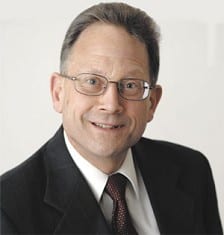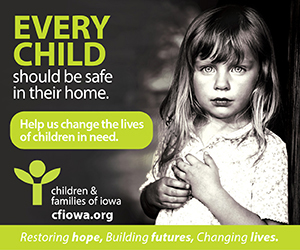Aging Resources connects seniors with services
Depression screening among programs agencies are rolling out statewide

As Iowa’s Baby Boomers begin reaching their mid-60s, both public and private agencies are being stretched to accommodate their growing needs. Aging Resources of Central Iowa is among the agencies that’s working to help seniors to “age in place” within their homes as long as possible. At the same time, state and industry officials are establishing a credentialing system for direct care workers aimed at encouraging more people to enter the field to address the increasing need.
“Lead, follow, or get out of the way.”
That no-nonsense philosophy worked well for Lee Iacocca in reinventing Chrysler Corp. in the 1980s. The expression still rings true today for Joel Olah as he works to reshape the delivery of elder care services in Central Iowa.
Olah, executive director of Aging Resources of Central Iowa, has worked in the elder care industry for the past 40 years and has led Aging Resources for the past 16. The organization’s mission is to connect people who are 60 and older and their families with resources to enable seniors to continue living in their homes – with assistance from family or professional in-home caregivers – so that they can remain independent longer.
“Our philosophy is simple,” Olah said. “The better we can equip a caregiver to perform what needs to be done, the better the quality of care, and the better the individual will do within that care setting.”
Providing information and referrals about such in-home services will become increasingly important as the Baby Boomer generation continues to age.
Each day, more than 8,000 Americans celebrate their 65th birthdays, which by the end of the year will increase the senior population to nearly 49 million. By 2030, Iowa’s over-65 crowd is expected to reach 838,000 residents, or 30 percent of the state’s population.
“We simply can’t afford to place people in institutional care in great numbers, because it’s too costly and there are not enough resources,” Olah said. “So what you’re going to have to do is redevelop that home- and community-based structure to accommodate the growth that is occurring.”
Helping seniors receive care in their homes produces significant savings compared with sending them to long-term care facilities.
“We currently have about 1,430 clients in our case management program, of which over 95 percent are on Title 19, or Medicaid,” Olah said. “We can serve their needs in-home, on average, for $550 a month, as opposed to $230 a day in a long-term care center. Our average length of stay in a program is 32 months. After that time, they either go to a long-term care center or to hospice – or they die or get better. So the amount of savings this program represents for the taxpayer is incredible.”
Part of a national network of more than 600 Area Agencies on Aging established by the Older Americans Act in 1973, Aging Resources of Central Iowa is one of 13 such agencies in the state. Serving an eight-county area – Boone, Dallas, Jasper, Madison, Marion, Polk, Story and Warren counties — Aging Resources works with nearly one out of four of the 121,000 residents age 60 and older in its service area.
Pioneering work
Using some models that have proved successful in other states as a springboard, Aging Resources’ 33-person staff is developing and testing new approaches to help caregivers stretch existing resources further. For instance, the organization is launching a mental-health screening program. In that initiative, case managers with each of the 13 area agencies on aging will be trained to spot depressed seniors and refer them to assistance programs, which should help them be more active and healthy and stay in their own homes longer.
“We’re kind of doing some pioneering work, which I think is pretty exciting,” said Olah, who at 62 doesn’t show any signs of slowing down. “When you have great opportunities like this, you don’t pass it up; you get in there and do it. Lee Iacocca said it the best: ‘Lead, follow or get the hell out of the way.’ I’m a Detroiter, so I can relate to Lee’s philosophy; if you’ve got the need and you can find the connection to the points, do it.”
Among these new programs is an initiative to address one of the most prevalent problems faced by seniors: undiagnosed depression. Through the “Transitions” program, Aging Resources staff members are working with counselors from Eyerly Ball Community Mental Health Services to speak to groups of seniors about depression. The outreach program is offered at congregate meal sites operated by Senior Services of Polk County.
“We want to teach them what some of the symptoms of depression are, so that they recognize them and say, ‘I need some help,’” said Cheryl Evans-Pryor, a community resource counselor with Aging Resources. Another initiative, the Program to Encourage Active Rewarding Living for Seniors (PEARLS), provides mental-health screening as part of quarterly home visits by Aging Resources case managers through the Senior Outreach Counseling Program.
“Part of the process in all of the programs is making that assessment, finding individuals that actually have depression, because often their physicians don’t ask those questions; they don’t have the time,” she said. “Depression is often paired with other health issues, such as chronic arthritis. We want to make sure we’re treating both illnesses. It’s very encouraging to know that depression is one of the most treatable illnesses there is.”
Evans-Pryor and another counselor are nationally certified and will train their counterparts at the other area agencies across the state to incorporate PEARLS into their case management programs. “And since we’ve already conducted the pilot and got all the bugs out of it, we can take the headaches out of the data compilation and tracking,” she said.
Olah said the training is a good example of how the state can build its capacity for senior care at the local level, because there are few geriatric psychiatrists practicing in Iowa.
“We only have six geriatric psychiatrists in the state, and most of them are located in Iowa City,” he said. “That does not help the rest of the state. And over half the psychologists in the state are over age 55 today, and there are not young people to follow in their path.”
Preferred choice
Staying in their own homes, as opposed to entering assisted living or other institutional settings, is the option that most seniors prefer, said Anne Peters, franchise owner of Home Instead Senior Care in West Des Moines.
“Overall, when you ask people where they want to be as they age, they say, ‘at home,’” said Peters, a former geriatric care case manager who bought the home-care franchise three years ago. Her business, which has operated in Greater Des Moines for 15 years, currently employs about 70 caregivers.
Home Instead is one of a number of companies, many of them national franchises, that provide nonmedical home-care services for seniors in Greater Des Moines.
Despite a difficult economy, the company has continued to experience the same the same double-digit revenue growth it has enjoyed for the past 10 years, Peters said.
Potential clients and their families have been more proactive in the past couple of years in contacting her company about services before the need becomes a crisis, Peters said.
“I think maybe awareness is one of the reasons,” she said. “Knowing there are alternatives to assisted living or long-term care.” Additionally, more people seem to realize “that it’s important to at least have a game plan in place, to have a place to start.”
Two of the fastest-growing areas of support that Aging Resources provides are its family caregiver and case management programs, Olah said.
“Our growing services are certainly aimed at those Boomers who are caring for their parents, and caring for their kids, because they never thought they would be caring for both at the same time and they lack the skills,” he said.
Through the family caregiver program, counselors can evaluate which services are needed, such as respite for someone caring for a spouse with Alzheimer’s disease. “The difficulties occur when you stretch a caregiver beyond where they feel comfortable,” he said. “That leads to frustration; that leads to poor care. And it could lead to abuse.”
In many instances, Aging Resources has sent counselors to Greater Des Moines’ largest employers to provide outreach. Those companies “realize their staffs are having issues with family caregiving,” he said. Though Aging Resources refers most of its clients to other nonprofit agencies, it also directs people to for-profit services such as Home Instead.
“Whether they’re profit or not-for-profit, it doesn’t matter as much when you’re referring people out, as long as you know the quality of the care is good,” Olah said. “The consumers must always be given a choice of providers, and they make the decision on who they want to deliver the service.”
After working in senior services for as long as he has, Olah said he still feels energized by the work “because there’s so much to do.”
“I can’t wait to get to get to my desk every day,” he said.
Legislation means redistribution of aging services in Iowa












